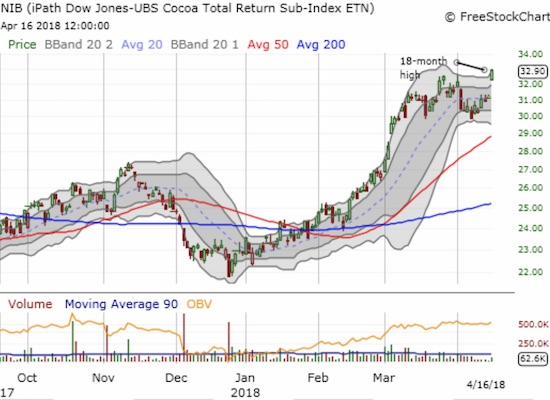In commodities, the time to get bullish is usually when prices are pressuring the industry and sentiment is persistently and deeply negative. The time to get bearish is usually when prices are skyrocketing, industry participants are celebrating wondrous fortunes, and sentiment is as euphoric as can be. Since I am long-term bullish on cocoa, I am prone to identify the buying opportunities and find reasons to hold through the bearish moments. Just last week, I gave my reasons for getting cautious enough to lock in profits on my holdings in iPath Bloomberg Cocoa SubTR ETN (NIB). Turns out cocoa still has some surprises: NIB broke out to a fresh 18-month high on the heels of a surge in the price of cocoa.

Source: FreeStockCharts.com
This kind of strong price action is usually driven by some abrupt weather event and/or strong pronouncements from analysts. Cocoa received both.
In the Ivory Coast, the world’s largest producer of cocoa, fears of damaging rains made the headlines for Reuters:
“Heavy rainfall could damage Ivory Coast’s April-September cocoa mid-crop, farmers said on Monday, as soil moisture content is high and trees are loaded with fragile flowers and cherelles.
The primary concern for farmers in recent months has been a lack of rainfall, but after a couple of weeks of downpours farmers in the world’s top cocoa producer are now hoping for less rain to protect yields as the harvest begins.”
Since weather is by nature unpredictable, I tend not to extrapolate too much from these kinds of projections. I prefer to wait for the actual weather and the actual impact. Granted that strategy will make me lag a market that is buzzing from weather expectations, but I prefer that risk rather than hoping I am rolling my dice with the lucky.
Bloomberg reported on the extremely bullish conclusions from Citigroup and Hackett Financial Advisors using a title that cannot get more loudly bullish: “Cocoa Goes Crazy as It’s Time to Be a `Raging Long-Term Bull’.” Apparently a Citigroup report talked about another supply deficit following this year’s projected deficit. Low prices in the previous cycle starved farms of proper maintenance and will lead to lower yields (see how the commodity cycle works?). Moreover, Indonesia, the world’s third largest producer (but far behind Ivory Coast and Ghana) is suffering agricultural issues from “…aging trees, diseases, extreme weather and better returns for other commodities.”
Ironically, contrary to the fears Reuters reported about the damage from heavy rainfall, Bloomberg cited fears of more dry weather from an El Nino weather pattern. Yet, the odds for an El Nino pattern by the Fall season is just 37%. These are measurable odds, but the odds are not “likely” until they get over 50%. In other words, traders are betting AGAINST the LIKELY (63%) chance El Nino will never arrive this year.
Nonetheless, the bulls are indeed raging. Hackett is projecting a retest of the 32-year highs set in 2011. Bloomberg shows that hedge funds are still piling into long cocoa futures: last week produced a new high for the run-up.
From my vantage point, it seems misplaced to bet on yet higher and higher prices here in the short-term. A sharp sell-off will likely result from any disappointment or disruption in the current price catalysts. Aggressive traders can of course go long and put in a stop loss configured for individual risk tolerance like below Monday’s low, below Monday’s gap, or below the triple low from March to April.
Ultimately, I am now rooting first and foremost for the cocoa farmers to receive the best price they can get for their precious crops (although I am afraid a lot of this year’s crop was sold forward at much lower prices). But I am also ready to buy into the next pullback.
Be careful out there!
Full disclosure: no positions
